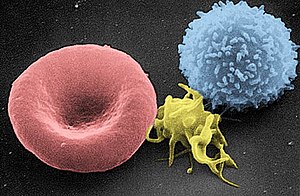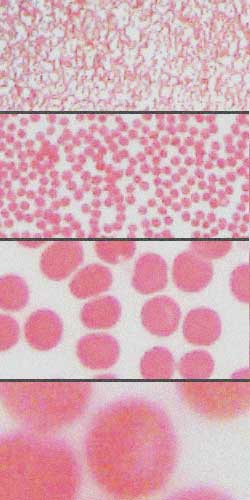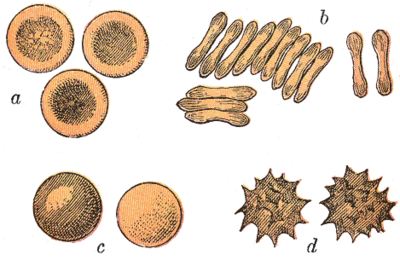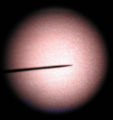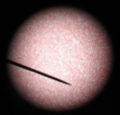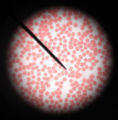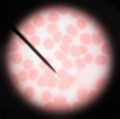Red blood cells: Difference between revisions
imported>Michael Benjamin No edit summary |
imported>Meg Taylor No edit summary |
||
| (18 intermediate revisions by 9 users not shown) | |||
| Line 1: | Line 1: | ||
{{subpages}} | |||
[[image:redbloodcells.jpg|right|frame|Human red blood cells]] '''Red blood cells''' are the most common type of [[blood cell]] and the [[vertebrate]] [[body]]'s principal means of delivering [[oxygen]] from the [[lung]]s or [[gill]]s to body tissues via the [[blood]]. | [[image:redbloodcells.jpg|right|frame|Human red blood cells]] '''Red blood cells''' are the most common type of [[blood cell]] and the [[vertebrate]] [[body]]'s principal means of delivering [[oxygen]] from the [[lung]]s or [[gill]]s to body tissues via the [[blood]]. | ||
Red blood cells are also known as '''RBCs''' or '''erythrocytes''' (from [[Greek language|Greek]] ''erythros'' for "red" and ''kytos'' for "hollow", with ''cyte'' nowadays translated as "cell"). A '''schistocyte''' is a red blood cell undergoing fragmentation, or a fragmented part of a red blood cell. | Red blood cells are also known as '''RBCs''' or '''erythrocytes''' (from [[Greek language|Greek]] ''erythros'' for "red" and ''kytos'' for "hollow", with ''cyte'' nowadays translated as "cell"). A '''schistocyte''' is a red blood cell undergoing fragmentation, or a fragmented part of a red blood cell. | ||
== | ==Function== | ||
[[Image:Red White Blood cells.jpg|thumb|From left to right: [[erythrocyte]], [[Platelet|thrombocyte]], [[leukocyte]].]] | [[Image:Red White Blood cells.jpg|thumb|From left to right: [[erythrocyte]], [[Platelet|thrombocyte]], [[leukocyte]].]] | ||
Erythrocytes consist mainly of [[ | Erythrocytes consist mainly of [[hemoglobin]], a complex [[molecule]] containing [[heme]] groups whose [[iron]] atoms temporarily link to oxygen molecules in the lungs or gills and release them throughout the body. Oxygen can easily [[diffusion|diffuse]] through the red blood cell's [[cell membrane]]. Hemoglobin also carries some of the waste product [[carbon dioxide]] back from the tissues. (In humans, less than 2% of the total oxygen, and most of the carbon dioxide, is held in solution in the [[blood plasma]]). A related compound, [[myoglobin]], acts to store oxygen in [[muscle]] cells. | ||
The color of erythrocytes is due to the heme group of | The color of erythrocytes is due to the [[heme]] group of [[hemoglobin]]. The blood [[plasma]] is straw-colored alone, but the red blood cells change colors depending on the state of the [[hemoglobin]]: when combined with [[oxygen]] the resulting oxyhemoglobin is scarlet and when oxygen has been released, the resulting deoxyhemoglobin is darker, appearing bluish through the blood vessel walls. [[Pulse oximetry]] takes advantage of this color change to directly measure the [[artery|arterial]] [[blood]] [[oxygen saturation]] using [[colorimetric]] techniques. | ||
[[Image:Blood_magnifications.jpg|frame|right|Human blood cells magnified at 40x, 100x, 400x and 1000x.]] | |||
The | ==Evolutionary advantages of red blood cells== | ||
The sequestration of [[oxygen]]-carrying [[proteins]] inside [[cells]] (rather than having them dissolved in body fluid) was an important step in the [[evolution]] of [[vertebrates]]; it allows for less [[viscosity|viscous]] blood and higher concentrations of oxygen. | |||
==Mammalian erythrocytes== | ==Mammalian erythrocytes== | ||
| Line 48: | Line 49: | ||
** [[Pernicious anemia]] is an [[autoimmune disease]] wherein the body lacks [[intrinsic factor]], required to absorb [[vitamin B12]] from food. Vitamin B12 is needed for the production of hemoglobin. | ** [[Pernicious anemia]] is an [[autoimmune disease]] wherein the body lacks [[intrinsic factor]], required to absorb [[vitamin B12]] from food. Vitamin B12 is needed for the production of hemoglobin. | ||
** [[Aplastic anemia]] is caused by the inability of the [[bone marrow]] to produce blood cells. | ** [[Aplastic anemia]] is caused by the inability of the [[bone marrow]] to produce blood cells. | ||
** [[Pure red cell aplasia]] is caused by the | ** [[Pure red cell aplasia]] is caused by the inability of the bone marrow to produce only red blood cells. | ||
** [[Hemolysis]] is the general term for excessive breakdown of red blood cells. It can have several causes. | ** [[Hemolysis]] is the general term for excessive breakdown of red blood cells. It can have several causes. | ||
* The [[malaria]] parasite spends part of its life-cycle in red blood cells, feeds on their hemoglobin and then breaks them apart, causing fever. Both [[sickle-cell disease]] and [[thalassemia]] are more common in malaria areas, because these mutations convey some protection against the parasite. | * The [[malaria]] parasite spends part of its life-cycle in red blood cells, feeds on their hemoglobin and then breaks them apart, causing fever. Both [[sickle-cell disease]] and [[thalassemia]] are more common in malaria areas, because these mutations convey some protection against the parasite. | ||
| Line 58: | Line 59: | ||
== History == | == History == | ||
In | In 1658, the [[Netherlands|Dutch]] [[Jan Swammerdam]] was the first to describe red blood cells. He had used an early [[microscope]]. | ||
<gallery>Image:Blood_40.jpg|Blood magnified at 40x. | |||
Image:Blood_100.jpg|Blood magnified at 100x. | |||
Image:Blood_400.jpg|Blood magnified at 400x. | |||
Image:Blood_1000.jpg|Blood magnified at 1000x.</gallery> | |||
Revision as of 03:02, 19 September 2013
Red blood cells are the most common type of blood cell and the vertebrate body's principal means of delivering oxygen from the lungs or gills to body tissues via the blood.
Red blood cells are also known as RBCs or erythrocytes (from Greek erythros for "red" and kytos for "hollow", with cyte nowadays translated as "cell"). A schistocyte is a red blood cell undergoing fragmentation, or a fragmented part of a red blood cell.
Function
Erythrocytes consist mainly of hemoglobin, a complex molecule containing heme groups whose iron atoms temporarily link to oxygen molecules in the lungs or gills and release them throughout the body. Oxygen can easily diffuse through the red blood cell's cell membrane. Hemoglobin also carries some of the waste product carbon dioxide back from the tissues. (In humans, less than 2% of the total oxygen, and most of the carbon dioxide, is held in solution in the blood plasma). A related compound, myoglobin, acts to store oxygen in muscle cells.
The color of erythrocytes is due to the heme group of hemoglobin. The blood plasma is straw-colored alone, but the red blood cells change colors depending on the state of the hemoglobin: when combined with oxygen the resulting oxyhemoglobin is scarlet and when oxygen has been released, the resulting deoxyhemoglobin is darker, appearing bluish through the blood vessel walls. Pulse oximetry takes advantage of this color change to directly measure the arterial blood oxygen saturation using colorimetric techniques.
Evolutionary advantages of red blood cells
The sequestration of oxygen-carrying proteins inside cells (rather than having them dissolved in body fluid) was an important step in the evolution of vertebrates; it allows for less viscous blood and higher concentrations of oxygen.
Mammalian erythrocytes
Erythrocytes in mammals are anucleate when mature, meaning that they lack a cell nucleus and thus have no DNA. In comparison, the erythrocytes of nearly all other vertebrates have nuclei; the only known exception is salamanders of the Batrachoseps genus. Mammalian erythrocytes also lose their other organelles including their mitochondria and produce energy by fermentation, via glycolysis of glucose followed by lactic acid production. Furthermore, red cells do not have an insulin receptor and thus glucose uptake is not regulated by insulin. As a result of the lack of nucleus and organelles, the cells cannot produce new structural or repair proteins or enzymes and their lifespan is limited.
Mammalian erythrocytes are biconcave disks: flattened and depressed in the center, with a dumb-bell shaped cross section. This shape (as well as the loss of organelles and nucleus) optimizes the cell for the exchange of oxygen with its surroundings. The cells are flexible so as to fit through tiny capillaries, where they release their oxygen load. Erythrocytes are circular, except in the camel family Camelidae, where they are oval.
In large blood vessels, red blood cells sometimes occur as a stack, flat side next to flat side. This is known as rouleaux formation, and it occurs more often if the levels of certain serum proteins are elevated, as for instance during inflammation.
The spleen acts as a reservoir of red blood cells, but this effect is somewhat limited in humans. In some other mammals such as dogs and horses, the spleen sequesters large numbers of red blood cells which are dumped into the blood during times of exertion stress, yielding a higher oxygen transport capacity.
Human erythrocytes
The diameter of a typical human erythrocyte disk is much smaller than most other human cells. A typical erythrocyte contains about 270 million hemoglobin molecules, with each carrying four heme groups.
Adult humans have roughly 2–3 × 1013 red blood cells at any given time (women have about 4 million to 5 million erythrocytes per cubic millimeter (microliter) of blood and men about 5 million to 6 million; people living at high altitudes with low oxygen tension will have more). Red blood cells are thus much more common than the other blood particles: There are about 4,000–11,000 white blood cells and about 150,000–400,000 platelets in a cubic millimeter of human blood. The red blood cells store collectively about 3.5 grams of iron, more than five times the iron stored by all the other tissues combined.
The process by which red blood cells are produced is called erythropoiesis. Erythrocytes are continuously being produced in the red bone marrow of large bones, at a rate of about 2 million per second. (In the embryo, the liver is the main site of red blood cell production.) The production can be stimulated by the hormone erythropoietin (EPO), synthesised by the kidney; which is used for doping in sports. Just before and after leaving the bone marrow, they are known as reticulocytes which comprise about 1% of circulating red blood cells. Erythrocytes develop from stem cells through reticuloctyes to mature erythrocytes in about 7 days and live a total of about 120 days. The aging cells swell up to a sphere-like shape and are engulfed by phagocytes, destroyed and their materials are released into the blood. The main sites of destruction are the liver and the spleen. The heme constituent of hemoglobin is eventually excreted as bilirubin.
The blood types of humans are due to variations in surface glycoproteins of erythrocytes.
Red blood cells can be separated from blood plasma by centrifugation. During plasma donation, the red blood cells are pumped back into the body right away, and the plasma is collected. Some athletes have tried to improve their performance by doping their blood: First about 1 litre of their blood is extracted, then the red blood cells are isolated, frozen and stored, to be reinjected shortly before the competition. (Red blood cells can be conserved for 5 weeks at −78 °C.) This practice is hard to detect but may endanger the human cardiovascular system which is not equipped to deal with blood of the resulting higher viscosity.
Diseases and diagnostic tools
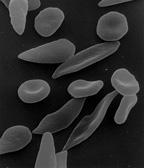
Blood diseases involving the red blood cells include:
- Anemias (or anaemias) are diseases characterized by low oxygen transport capacity of the blood, because of low red cell count or some abnormality of the red blood cells or the hemoglobin.
- Iron deficiency anemia is the most common anemia; it occurs when the dietary intake or absorption of iron is insufficient, and hemoglobin, which contains iron, cannot be formed
- Sickle-cell disease is a genetic disease that results in abnormal hemoglobin molecules. When these release their oxygen load in the tissues, they become insoluble, leading to mis-shaped red blood cells. These sickle shaped red cells are rigid and cause blood vessel blockage, pain, strokes, and other tissue damage.
- Thalassemia is a genetic disease that results in the production of an abnormal ratio of hemoglobin subunits.
- Spherocytosis is a genetic disease that causes a defect in the red blood cell's cytoskeleton, causing the red blood cells to be small, sphere-shaped, and fragile instead of donut-shaped and flexible.
- Pernicious anemia is an autoimmune disease wherein the body lacks intrinsic factor, required to absorb vitamin B12 from food. Vitamin B12 is needed for the production of hemoglobin.
- Aplastic anemia is caused by the inability of the bone marrow to produce blood cells.
- Pure red cell aplasia is caused by the inability of the bone marrow to produce only red blood cells.
- Hemolysis is the general term for excessive breakdown of red blood cells. It can have several causes.
- The malaria parasite spends part of its life-cycle in red blood cells, feeds on their hemoglobin and then breaks them apart, causing fever. Both sickle-cell disease and thalassemia are more common in malaria areas, because these mutations convey some protection against the parasite.
- Polycythemias (or erythrocytoses) are diseases characterized by a surplus of red blood cells. The increased viscosity of the blood can cause a number of symptoms.
- In polycythemia vera the increased number of red blood cells results from an abnormality in the bone marrow.
- Several microangiopathic diseases, including disseminated intravascular coagulation and thrombotic microangiopathies, present with pathognomonic (diagnostic) RBC fragments called schistocytes. These pathologies generate fibrin strands that sever RBCs as they try to move past a thrombus.
Several blood tests involve red blood cells, including the RBC count (the number of red blood cells per volume of blood) and the hematocrit (percentage of blood volume occupied by red blood cells). The blood type needs to be determined to prepare for a blood transfusion or an organ transplantation.
History
In 1658, the Dutch Jan Swammerdam was the first to describe red blood cells. He had used an early microscope.

